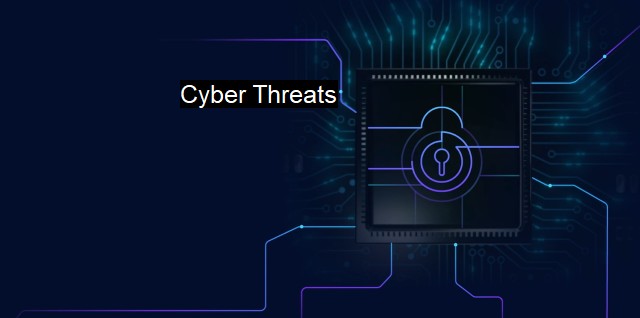What are Cyber Threats?
Cyber Threats and Cybersecurity: Understanding the Risks and Antivirus Solutions
Cyber threats are unlawful activities primarily aimed at compromising computer networks, resulting in mental or financial damage. These violate the victim's sense of security by infriving on their privacy rights, corrupting data, stealing confidential information, transferring money, causing damage, and leaving behind numerous complications. Cyber threats consist of three major components: vulnerability, threat, and attack.Vulnerability refers to the weaknesses in a network that enable cyber attackers to exploit these cracks. Threats are potential targeting instances of vulnerabilities by cybercriminals. an attack is when the cybercriminals use threats to prey on the vulnerabilities. It is the perpetrator's quest to break the victim's cybersecurity and implement malicious actions.
Cyber threats aren't just a matter of computers and software. They frequently involve complicated strategies devised by cybercriminals to make the most of network vulnerabilities. While the modes of implementation may be complex, cybercriminals usually have typical objectives such as interrupting operations, physical damage, theft of intellectual property, or gaining unauthorized access to systems.
Today, cyber threats have evolved to be much more sophisticated and harmful. There's a great variety of cyber threats that probe's oner's digital life on a macro and a micro-level - viruses, malware, ransomware, SQL injection, and phishing are just some examples that demonstrate the risk spectrum.
Viruses are a type of malicious software designed to sneak onto your computer and damage or delete files by replicating. Malware acts in the shadows, silently monitoring your computer activity, harvesting personal or system information. Ransomware threatens to wipe your data unless you pay a ransom. SQL injection manipulates databases into revealing data, and phishing tricks you into providing personal data by pretending to be a reputable company in email communications. For individuals, companies, and governments, these threats can cause havoc, both financially and operationally.
Antivirus software offers a basic tier of security by detecting and removing common threats before they can do any harm. Today, antivirus software has evolved into broader cybersecurity solutions to keep pace with the burgeoning, increasingly sophisticated world of digital threats. These platforms offer comprehensive protections obvious threats like worms and Trojans, obscure threats like rootkits, and evolving threats like ransomware.
Nonetheless, whether with or without antivirus software, heavy internet users must undertake responsible cybersecurity hygiene. Secure data surfing, being cautious about email from unknown sources, regular updates of systems and software, password complexities, and data encryptions are just few of the ways to dampen the vulnerability quotient.
Cyber threats are the growing reality of the exponential growth in digital technologies. Individuals, businesses, or governments - every digital participant is a potential victim. Hence, in our pursuit of exploiting the digital advancements, it's equally indispensable that equal measures are put into securing the digital world. Cybersecurity is not an option; rather, it operates as a necessity in the increasingly interconnected world.
While the latest antivirus software provides formidable frontline defenses, no cybersecurity solution is impervious. Making cybersecurity a priority, generating public consciousness, developing robust security protocols, improving system architecture, promoting secure online behavior, and creating robust laws and regulations will help subdue the menace of cyber threats. After all, with today's digital intrusions seeing no end, the counteraction should match the same pace, if not more.
Invariably, being cautious about what comes from the internet, brushing up on basic cybersecurity measures, and maintaining sound digital practices will prove to be the most potent antidote to cyber threats. The intricacies of cybersecurity are proportional to the sophistication of threats. But, one cannot underscore enough that being the first line of defense against these threats begins with embedment of safe cyber practices and fostering a synchronized effort toward a cyber secure environment.
Hence, in the broader context of understanding, cyber threats are not merely the jeopardy induced through network vulnerabilities; they also represent a crucial test to the adaptive abilities of an individual, company, or nations in securing their digital frontiers amidst accelerating rapid progress in technology. Each advancing step in the digital age garners the call for incredible tenacity and urgency in erecting and strengthening cybersecurity walls every passing second. Thus, in this ceaseless clamber, the nature and understanding of cybersecurity are invincibly intertwined with every facet of living in a digital world.

Cyber Threats FAQs
What are cyber threats?
Cyber threats are malicious activities or attacks performed through the internet and other digital channels, which aim to gain unauthorized access, manipulate, or destroy sensitive information.How can cyber threats affect me or my organization?
Cyber threats can have severe consequences, ranging from financial losses to reputational damage, and even legal implications. They can compromise confidential data, disrupt business operations, hijack personal identities, spread malware, or launch cyber espionage.What are some common types of cyber threats?
Some common types of cyber threats include phishing, ransomware, malware, trojan horses, viruses, worms, denial-of-service attacks, botnets, social engineering, and advanced persistent threats.How can antivirus software help protect against cyber threats?
Antivirus software can detect, block, and remove malicious software and files from your computer or network. It can also scan incoming emails, downloads, and attachments for any potential threats. By regularly updating your antivirus software and running regular scans, you can significantly reduce the risk of cyber threats.| | A | | | B | | | C | | | D | | | E | | | F | | | G | | | H | | | I | | | J | | | K | | | L | | | M | |
| | N | | | O | | | P | | | Q | | | R | | | S | | | T | | | U | | | V | | | W | | | X | | | Y | | | Z | |
| | 1 | | | 2 | | | 3 | | | 4 | | | 7 | | | 8 | | |||||||